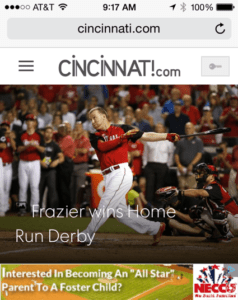Having a solid geofencing marketing strategy has became a major marketing buzz word over the last 7-8 years. Geofencing is a tool that can be used from everything from marketing to logistics. In this post we cover 5 tips for the most common form of geofencing, marketing with display advertising or “mobile banner ads“. In 2022 it is said in recent research studies that the Geofencing industry will reach 1.5B. That is a lot of money using this tool. Our goal is to inform marketing professionals some easy tips to use this tool as effectively as possible.
4 Tips to improve your geofencing marketing strategy.
- Use Time & Dates – Timing is everything. Place yourself in your customer shoes and think when would they be looking at their device. For example; If you are geofencing an event, be sure to bookend the event and hit mobile users as they wait for event to start or sitting in traffic getting out over parking areas.
- Be Creative – We have said this before and will say it again, creativity is key. When using a marketing tool such as geofencing it is to increase relevance. Be sure to craft the ads in the same way. For example; While advertising around the event such as a game, have a sports theme ad or speak directly to that time. “Call the Pros” “Be an AllStar” “Real MVP” or just “Enjoying the game”? Any extra creativity can add to relevance and overall effectiveness of the campaign. Don’t shortcut ad design, we see almost double click through rate increases due to ad design.

- Call to action – Mobile display ads are for branding. No matter what you hear, that is their best asset. The visual natural of the ad itself is the same as a billboard on someones mobile device. What makes banner ads better that a billboard is that they are clickable. Many times though marketing teams really want to measure goals based around clicks, or conversions, but forget one simple thing, a call to action. A call to action is giving the mobile user a reason to click. The better call to action reflects a better CTR (click through rate).
- Landing page – Please do not forget the landing page is a major part of the overall strategy. Many times ad approval is linked to whether the landing page reflects the same information as the advertisement. The landing page or linking URL is where the ad link to after click. Have a landing page that is not mobile friendly or gives a quick user experience is common mistakes made in your geofencing marketing strategy.
When using advertising tools it is important not to get caught up in the buzz. Not all campaigns need to use tight location radiuses or virtual perimeters to trigger an action or request. Sometimes a larger area make perfect sense or using other targeting tools can provide better results. We recommend doing research and speak with a profession like from Thumbvista to find out exactly what makes most sense for your business.
Thumbvista offers self service with assistance along managed services for more complex campaigns that need customizations. Reach out today to brainstorm your company’s geofencing marketing strategy.

